On August 25, Blizzard sued Turtle-WoW, demanding nearly a billion dollars in statutory damages, domain seizure, wallet freezes, and a permanent injunction.
This isn’t just another IP enforcement action. It’s the first private-server crackdown since Scapegaming in 2010. And Blizzard picked Turtle-WoW not because it was small and vulnerable, but because it was successful. Turtle’s very existence embarrassed the mothership by showing that a tiny, volunteer team could out-Warcraft Warcraft.
From Warcraft to Safecraft
Retail WoW today doesn’t feel like Warcraft—it feels like a woke Disney theme park ride, one giant safe space where nothing dangerous, gritty, or surprising can happen. Even Asmongold, once Blizzard’s loudest megaphone, walked away, saying the game was unrecognizable. Subscriptions bled away through Shadowlands and Dragonflight.

The only thing keeping Warcraft’s division afloat is Classic. Players wanted the chance to relive 2004, 2007, 2010—not the theme-park disasters that followed. What they begged for wasn’t Cataclysm or Pandaria but a chance to build forward from Classic, BC, and Wrath. They wanted Classic+: the alternate timeline where Blizzard stayed true to Azeroth.
Blizzard didn’t deliver. Instead, they tossed out “Season of Discovery,” a Frankenstein experiment nobody asked for. The community wanted the real thing—and Turtle WoW provided it.
Turtle-WoW Shows the Way
Turtle’s numbers tell the story. Peak concurrent players reached 25,000, more than double Blizzard’s Classic Era realms. Donations rolled in at six figures a year—purely voluntary, no corporate squeeze.
But the real magic was the content. Handwritten quests that felt like lost RPG modules from 2005. A world tuned for fun, not for retention metrics. No DEI sermonizing, no HR side quests about intersectionality. Just game design.
Players flocked to it, not because it was free, but because it felt like Warcraft again. As one old-school fan put it: “We have money. We’d love to spend it on glorious Blizzard games… but you kept disappointing us.”
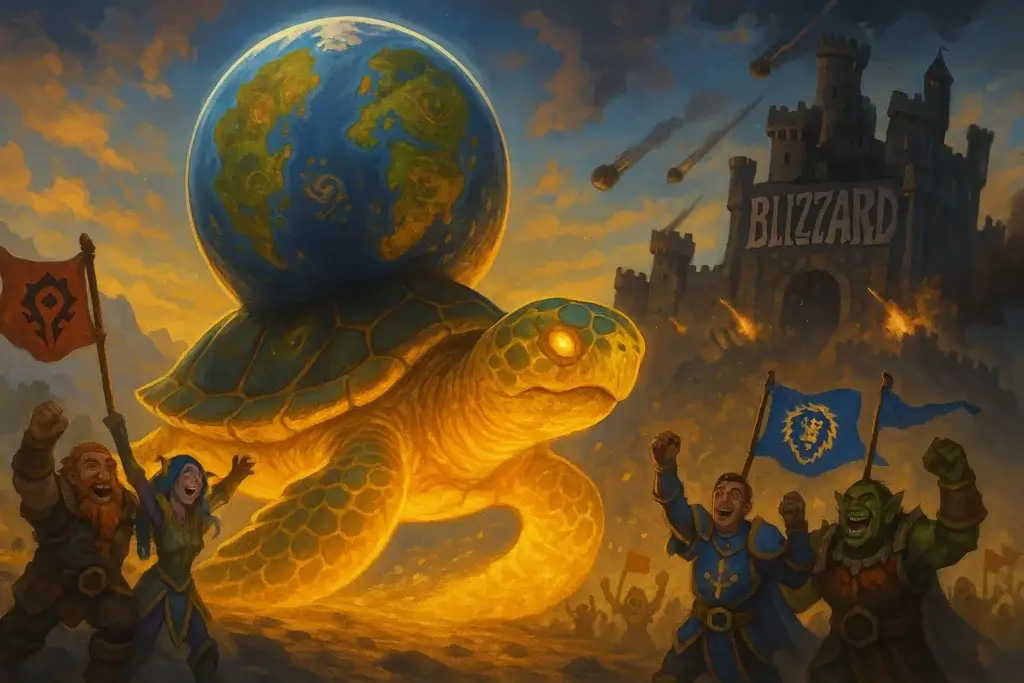
That’s the point critics of private servers miss: people aren’t fleeing to Turtle because it’s free. They’re paying donations happily because it’s the only place that still feels like Warcraft.
Why Blizzard Can’t Make Classic+
Here’s the uncomfortable truth: Blizzard cannot make Classic+. Not now, not ever. The team that built 1.12—Alex Afrasiabi, John Staats, Kevin Jordan, Chris Kaleiki, Jonathan LeCraft, Jesse McCree, Rob Pardo, Greg “Ghostcrawler” Street, and many more—was steadily purged or driven out between 2012 and 2021 under the banner of “culture change” and ESG-driven layoffs. And that’s just a fraction of the talent lost. Without them the egg cannot be reassembled.
Yes, Chris Metzen has returned, but his role today is ceremonial. He has no veto power and must defer to Blizzard’s DEI advisory structure. He is a eunuch, a mascot, not a craftsman. The real yolks—the designers who built Azeroth—are gone, and they are not coming back.
Censorship, Not Protection
Blizzard’s filing claims infringement on over 6,000 works—every texture, sound, and quest string. Yet Blizzard refuses to monetize those works itself. The IP is no longer creative fuel; it’s just a veto club.
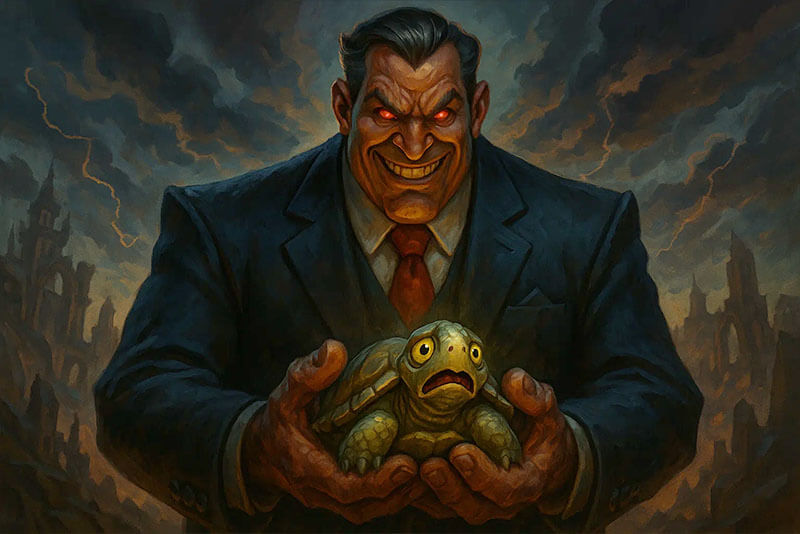
Blizzard will not build Classic+. It cannot build Classic+. But it cannot allow Turtle-WoW to prove that Classic+ is both possible and better. So it sues. Not to protect, but to smother. Not to create, but to destroy.
And even here, the victory will be pyrrhic. Turtle-WoW’s infrastructure is in Russia; enforcement will be symbolic at best. At most, Blizzard might bully PayPal or Stripe into choking off donations, but crypto and new rails will rise in their place. Even if Turtle gets nuked, it will respawn under a new shell, just as Nostalrius once did. Every swing of Blizzard’s legal club only confirms the humiliation: others can still do it better.
Meanwhile, Blizzard ignores its own house. Botting and RMT run rampant in Retail and Classic alike. If you can’t police your own game, suing volunteers looks less like integrity and more like hypocrisy.
Daybreak and the Wider Pattern
Blizzard isn’t alone. Daybreak Games has launched a nearly identical lawsuit against an EverQuest emulator, Project THJ. The parallels are obvious: EverQuest survives only through nostalgia, innovation comes from fan projects, and the official studio’s only move is litigation. Across the MMO landscape, corporations that once built worlds now merely sue those who still can.
Raging at the Puppet, Not the Strings
Even the loudest monologues blowing up on YouTube or Twitch don’t get it. They diagnose the symptoms—missing GMs, cash-shop creep, sloppy writing—but they miss the cause. The real disease isn’t “bad management” or “tone-deaf execs.” It’s the mandated corporate bloat of ESG compliance, proxy-advisor scorecards, and index-fund box-ticking.
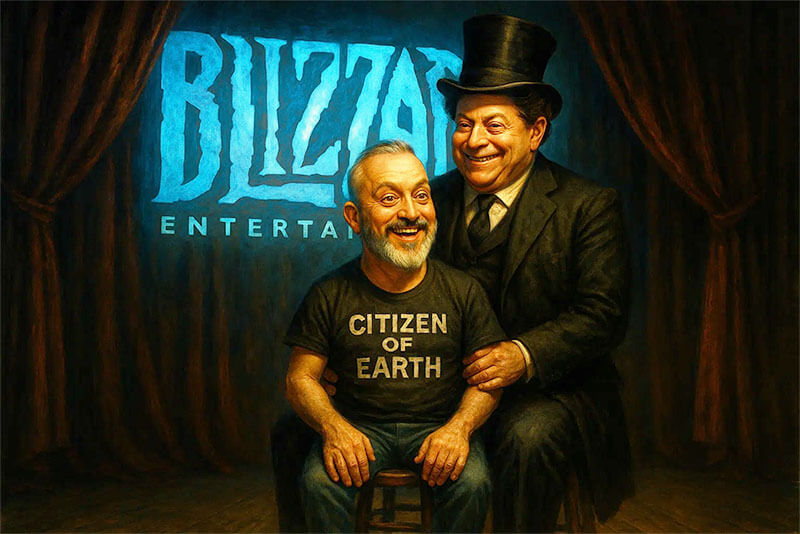
The pundits rage at the puppet. The strings are what matter.
Cheap ESG Money
The deeper rot lies in the executive suite. Blizzard had to be shamed into making WoW Classic in the first place, prodded by Mark Kern and the success of the Nostalrius server. The company that once defined PC gaming now has to be embarrassed into serving its own players. And when those players prove—through Turtle-WoW and Ascension—that better design is still possible, the C-suite’s only instinct is litigation.
The real parasite isn’t just HR or bad managers. It’s cheap ESG money. The easy capital flowing from BlackRock and friends pays for compliance, not creativity. Blizzard doesn’t need to make great games—it just needs to tick the right boxes and promise predictable monetization. That’s why WoW Retail became Safecraft: a woke, over-monetized safe space built to impress investors instead of players.
What ESG Compliance Means for Gamers
Most players don’t realize what “ESG compliance” actually looks like inside a studio. It doesn’t mean recycling bins in the breakroom. It means Blizzard is no longer in the business of pleasing you—the paying gamer. It’s in the business of pleasing the compliance regime.
That regime doesn’t reward fun. It rewards scorecards. And the easiest scorecard to max out is the “S” in ESG: Social. Unlike “E” (environment) or “G” (governance), the “S” pillar is cheap, fast, and highly visible. Fill your decks with DEI stats, LGBTQ virtue signals, and diversity pledges, and your ESG rating climbs overnight.
Think of it like carbon credits: a quick, easy way to pump up your score without fixing anything real. Blizzard can’t make Classic+, but it can drop a rainbow flag questline and instantly look “compliant.”
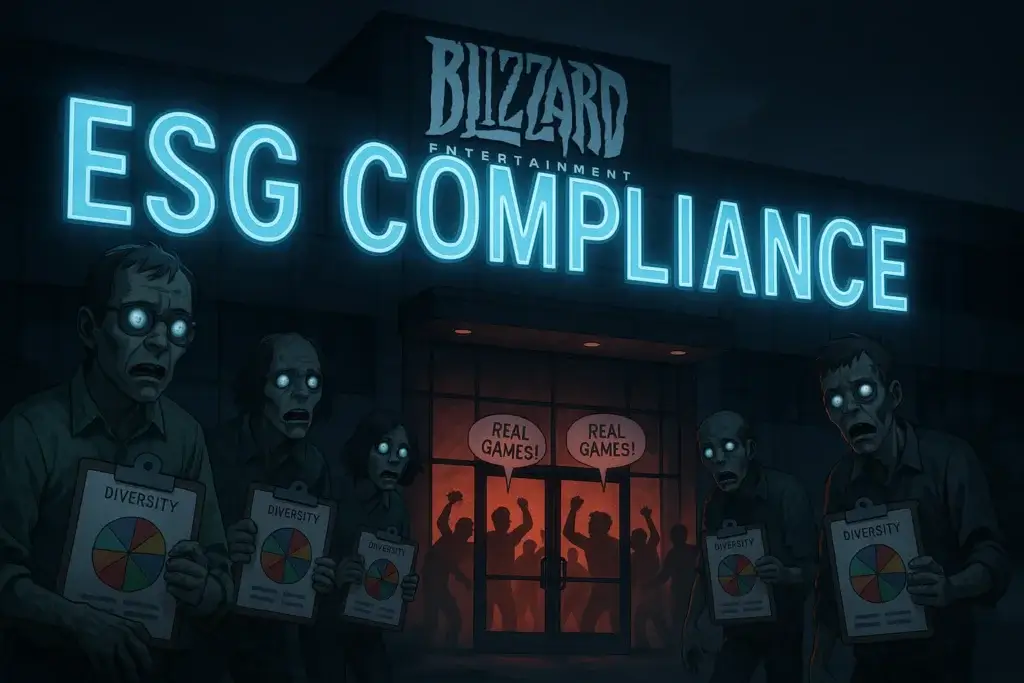
And here’s the kicker: high ESG scores mean better stock ratings and cheaper access to capital. If Blizzard plays by the regime’s rules, index funds shovel money in its direction, borrowing costs fall, and executives get their bonuses—no matter how badly the players suffer.
For gamers, that means two things:
- Artificial Wokeness Injected Into Worlds. Whole storylines, characters, and quests exist not because they serve the game, but because they serve the social scorecard. That’s why retail WoW feels more like a corporate training module than a living world.
- Loss of Cultural Empathy. By systematically filtering out white, male craftsmen—the very demographic that once was the core WoW player base—Blizzard replaced builders who understood their audience with hires who often can’t empathize with it at all. The result is sterile “inclusive” content that pleases proxy firms but alienates actual players.
Blizzard doesn’t have to win you back. It just has to show the board that the quotas are filled, the pledges are made, and the compliance forms are filed. That’s the business it’s in now.
The Flaw in Blizzard’s ESG Gamble
Blizzard’s entire strategy assumes players will keep subscribing and buying microtransactions no matter how hollow the game becomes. For a time, ESG can mask the rot—high scores pump the stock rating, cheap capital flows in, and executives cash their bonuses.
But content is already degrading, and players are already leaving. Turtle-WoW and Ascension exist precisely because Blizzard failed its own audience. You cannot build Safecraft forever and expect Warcraft loyalty to hold.
ESG can delay reality. It cannot repeal it. The law of the marketplace is undefeated. No ESG scheme can prevail in the long run.
Market Capture, Not Market Failure
Classic supply-and-demand logic has been legally subordinated to compliance mandates. When a company’s cost floor is set by ESG quotas and HR bloat, and index funds reward that floor, there is zero marginal incentive to cater to customer demand. The game can rot and players can flee—yet executive compensation and proxy ratings still rise.
That isn’t market failure. It’s market capture.
Why Most People Don’t See It
Do most Americans know what’s going on? No. Poll after poll shows the majority still equate ESG with “environmental common sense” and have never heard the term compliance-driven cost base. Until those abstractions translate into lived pain—lost wages, shuttered factories, $7 eggs, or even their favorite game’s GM staff disappearing—most assume the old rules still apply. They still believe the market is governed by supply and demand. It isn’t.
And the cost is real. Economic think tanks and financial reports estimate that ESG compliance and its associated policies impose an annual burden of $2,500 to $5,000 per American household. The bill for corporate box-ticking doesn’t vanish; it trickles down to you.
This is a massive wealth transfer from working- and middle-class Americans to a new class of unaccountable ESG auditors, corporate bureaucrats, and green energy grifters. It is a regressive tax that hurts the poor and middle class the most, all to serve a globalist agenda that seeks to control capital and dismantle the foundations of Western industrial society.
Players Vote With Their Feet
But players have already rendered their verdict. They vote with their feet and their wallets. That’s why Turtle-WoW surged past Blizzard’s official realms. That’s why Ascension thrives. That’s why gamers are dusting off titles from 1999 to 2009—the last dangerous, unfiltered decade before committees and compliance officers seized control. The same pattern is happening in film and television, where streaming libraries collapse into woke filler while audiences go back to DVDs and box sets of shows made when writing still mattered.
The Future Belongs to Players
Players aren’t waiting around for permission anymore. They’ve taken matters into their own hands, building the games and worlds they actually want to play. Turtle-WoW is proof. Ascension is proof. EverQuest emulators are proof. These fan projects succeed not because they’re free, but because they deliver what billion-dollar publishers no longer can: danger, imagination, and soul.
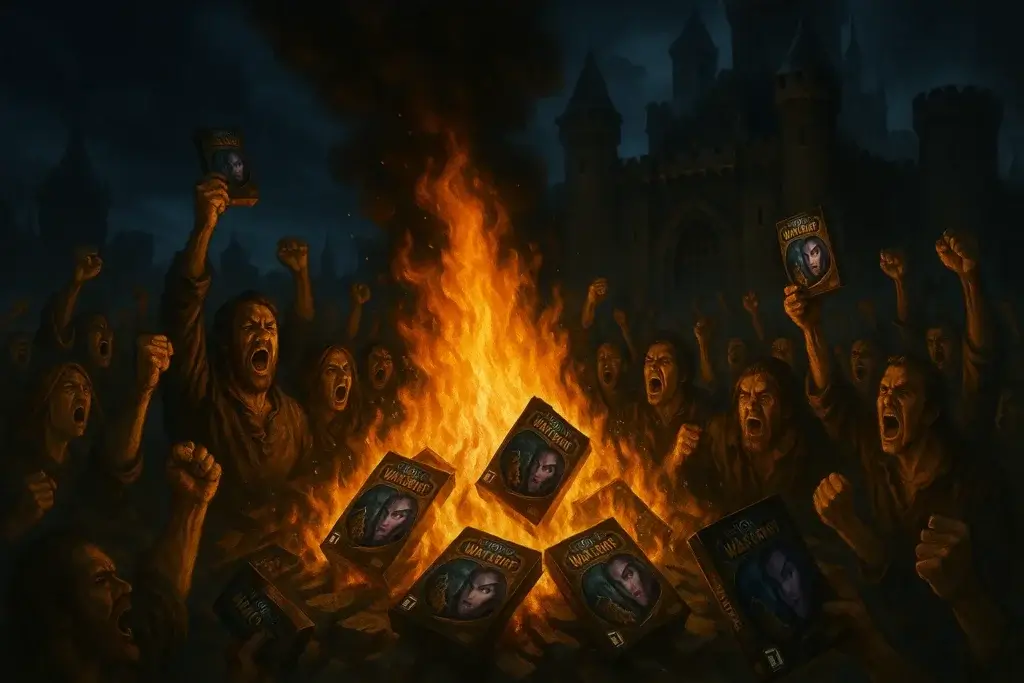
And this is only the beginning. Once AI tools put real development power into the hands of passionate hobbyists, the corporate gatekeepers will be irrelevant. The law of supply and demand still rules. Players are not automatons. They cannot be force-fed ESG-approved content and told it’s fun. They want dangerous worlds, and if the corporations won’t supply them, they’ll build them themselves.
Even when veterans return, like Chris Metzen, their power is ceremonial. Even when veterans move on, like Greg Street, they leave because the ecosystem that once allowed Warcraft to flourish no longer exists. The yolks are gone, the creative soil is salted, and the egg cannot be put back together.
Warcraft survives, but not because of Blizzard.
Conclusion: From Warcraft to Safecraft, From America to Managerial Corporatism
This is not the America I knew. It isn’t. The old America ran on risk, ownership, and the price signal. This new America—call it managerial corporatism—runs on compliance mandates, passive-voting cartels, and ESG overhead. Same flag, different operating system. The country you remember hasn’t vanished; it was simply rewritten while most of us weren’t looking.
Blizzard’s decline is just one shard of the bigger collapse. Players still want dangerous worlds. They still want craftsmanship, not compliance. And when corporations won’t supply it, they will build it themselves. Warcraft survives, but not because of Blizzard.
—Wolfshead

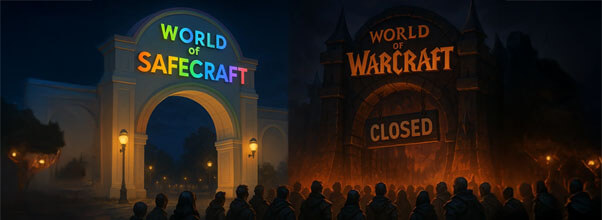


While not related to WoW in general, I want to say that all this shoving in players’ faces of LGHDTV+ content is making the whole “community” of these people absolutely appalling and disgusting to me. Originally, I didn’t care about them and was OK for them to do whatever they want with their lives, but now I have absolutely zero sympathy with them. Whenever I see any media piece that has that, I immediately scratch it off my list. Even if a game is OK, but in character creation has Body Type 1/2 instead of Male/Female, I don’t touch it.
In my opinion, this is a plan on a global scale to brainwash people into accepting this garbage and I already see it in kids – they think this is OK and they “celebrate it” even though it doesn’t concern them. I’ve heard from a teacher in elementary/middle school that kids do this for attention from their classmates and everyone else – they decide each day what “gender” they are. Some music teacher in Canada from my Balkan country said one of her students all day walked on all fours, meowed like a cat and the school even put a kitty litter for her. She got so frustrated she asked the kid “do you want me to bring you live mice for you to eat like a cat?” and all the kids got offended by her. She also said that on teacher meetings all the other Canadian teachers would stay mute and never voice their opinion, blindly trusting their government, when she spoke out, she never got support from her coworkers, they were too scared. Only one fellow Canadian teacher told her “I admire you people from the Balkans, because you always say what you really feel and don’t keep it in yourself”. And this was the only appreciation she got. Eventually she got so demoralized that she quit her job that she used to love and returned to her home country. Imagine, to escape “the good life” of North America to go back to your “second world dump of a country” because you can’t stand what’s going on.